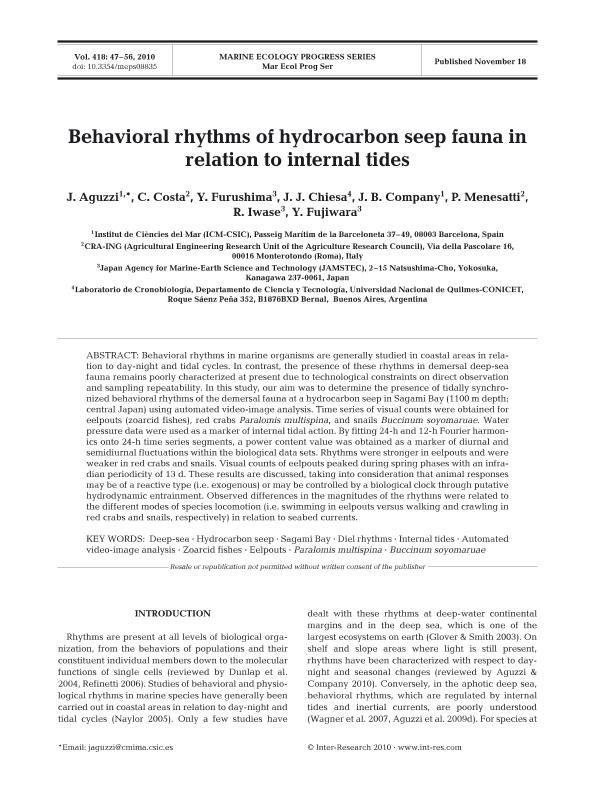Artículo
Behavioral rhythms of hydrocarbon seep fauna in relation to internal tides
Aguzzi, J.; Costa, C.; Furushima, Y.; Chiesa, Juan José ; Company, J. B.; Menesatti, P.; Iwase, R.; Fujiwara, Y.
; Company, J. B.; Menesatti, P.; Iwase, R.; Fujiwara, Y.
 ; Company, J. B.; Menesatti, P.; Iwase, R.; Fujiwara, Y.
; Company, J. B.; Menesatti, P.; Iwase, R.; Fujiwara, Y.
Fecha de publicación:
11/2010
Editorial:
Inter-Research
Revista:
Marine Ecology Progress Series
ISSN:
0171-8630
Idioma:
Inglés
Tipo de recurso:
Artículo publicado
Clasificación temática:
Resumen
Behavioral rhythms in marine organisms are generally studied in coastal areas in relation to day-night and tidal cycles. In contrast, the presence of these rhythms in demersal deep-sea fauna remains poorly characterized at present due to technological constraints on direct observation and sampling repeatability. In this study, our aim was to determine the presence of tidally synchronized behavioral rhythms of the demersal fauna at a hydrocarbon seep in Sagami Bay (1100 m depth; central Japan) using automated video-image analysis. Time series of visual counts were obtained for eelpouts (zoarcid fishes), red crabs Paralomis multispina, and snails Buccinum soyomaruae. Water pressure data were used as a marker of internal tidal action. By fitting 24-h and 12-h Fourier harmonics onto 24-h time series segments, a power content value was obtained as a marker of diurnal and semidiurnal fluctuations within the biological data sets. Rhythms were stronger in eelpouts and were weaker in red crabs and snails. Visual counts of eelpouts peaked during spring phases with an infradian periodicity of 13 d. These results are discussed, taking into consideration that animal responses may be of a reactive type (i.e. exogenous) or may be controlled by a biological clock through putative hydrodynamic entrainment. Observed differences in the magnitudes of the rhythms were related to the different modes of species locomotion (i.e. swimming in eelpouts versus walking and crawling in red crabs and snails, respectively) in relation to seabed currents.
Archivos asociados
Licencia
Identificadores
Colecciones
Articulos(SEDE CENTRAL)
Articulos de SEDE CENTRAL
Articulos de SEDE CENTRAL
Citación
Aguzzi, J.; Costa, C.; Furushima, Y.; Chiesa, Juan José; Company, J. B.; et al.; Behavioral rhythms of hydrocarbon seep fauna in relation to internal tides; Inter-Research; Marine Ecology Progress Series; 418; 11-2010; 47-56
Compartir
Altmétricas



